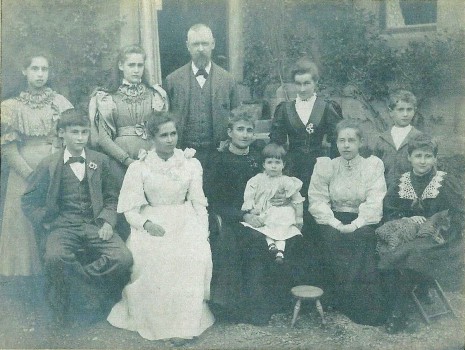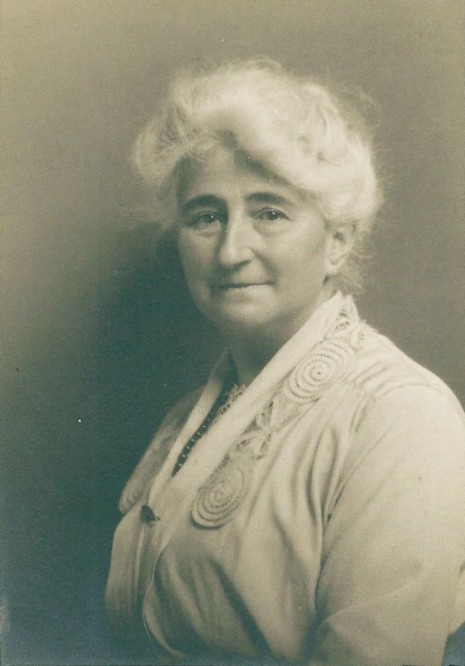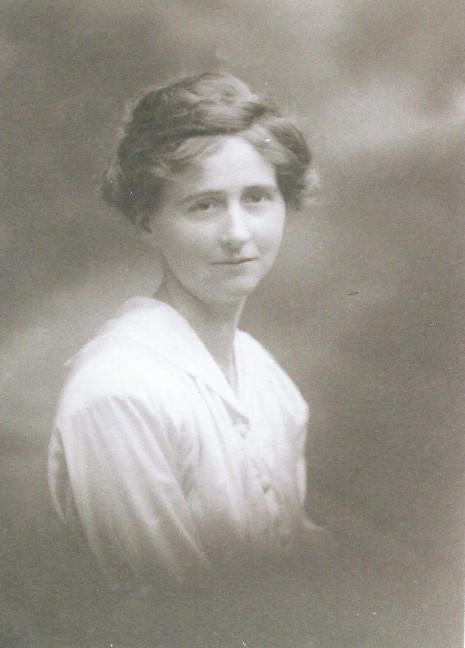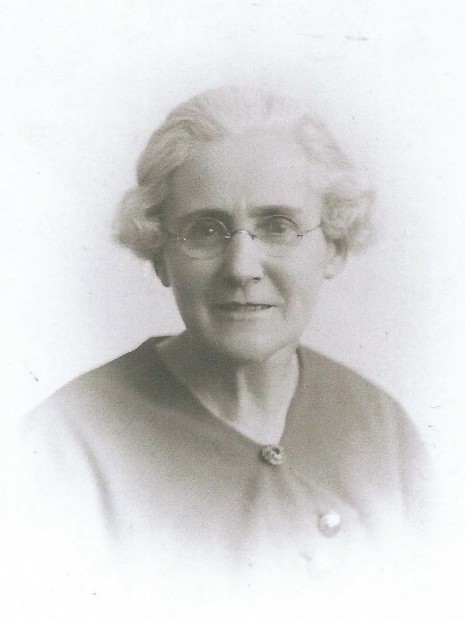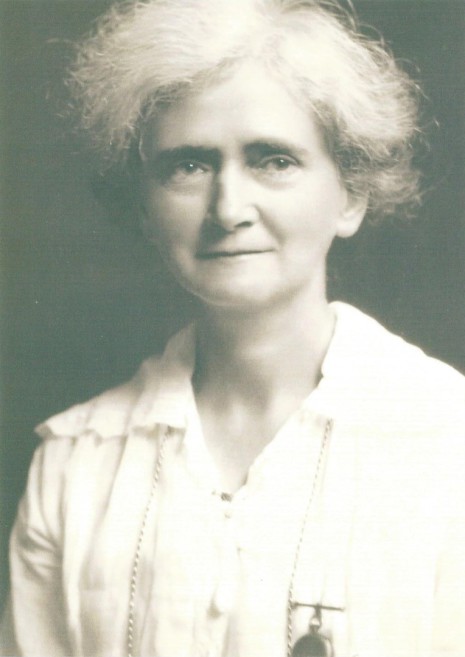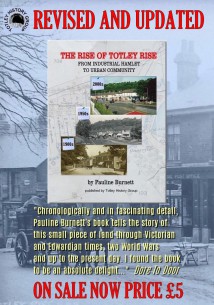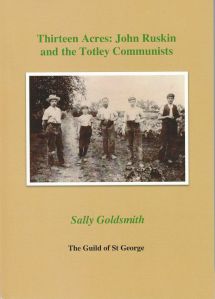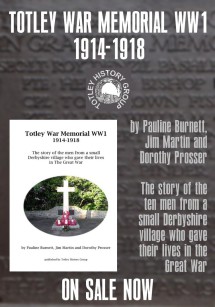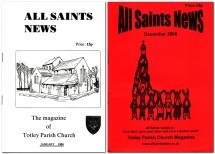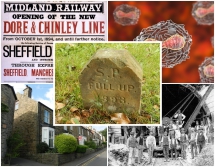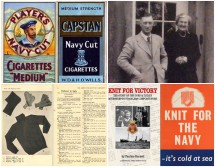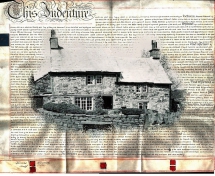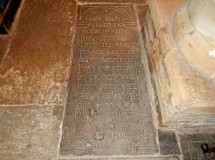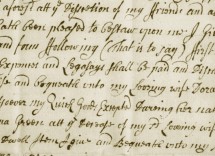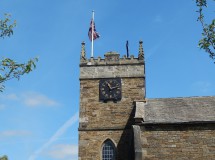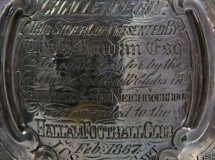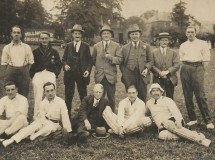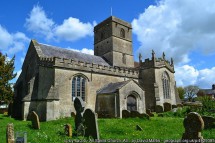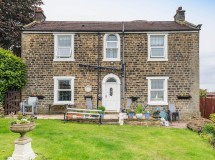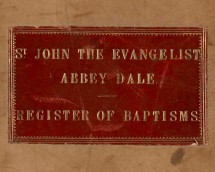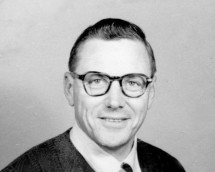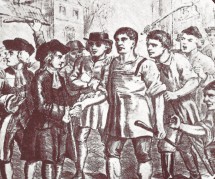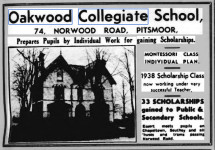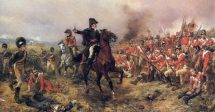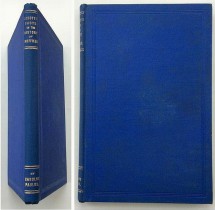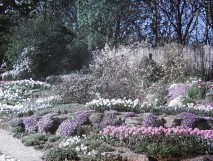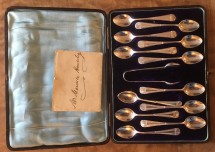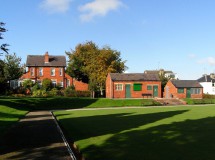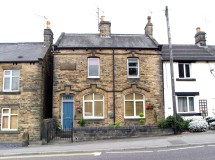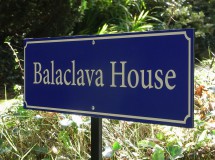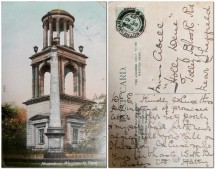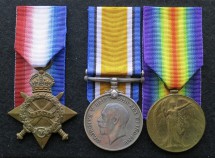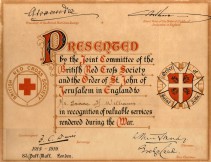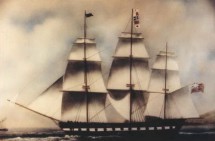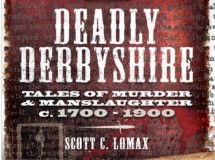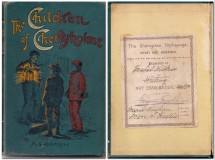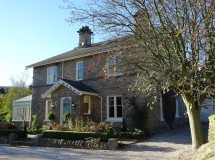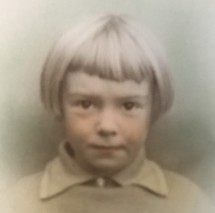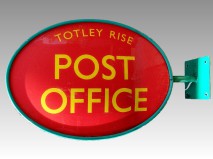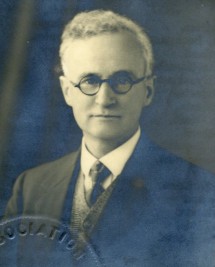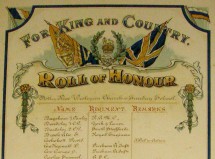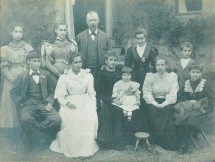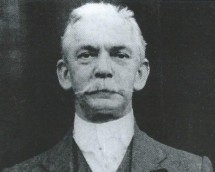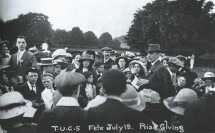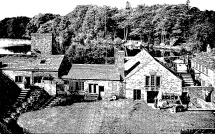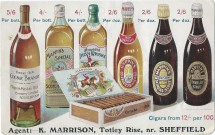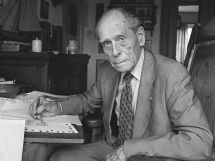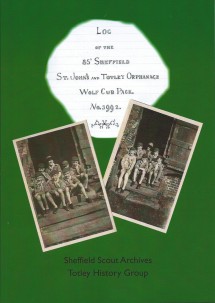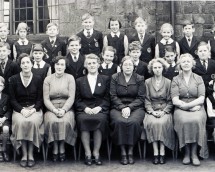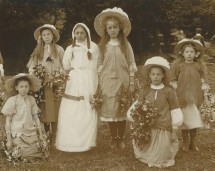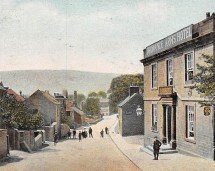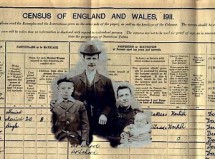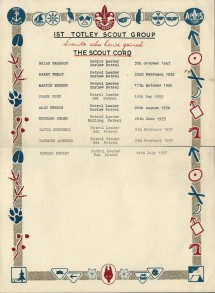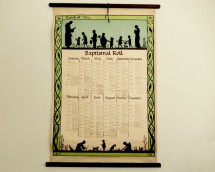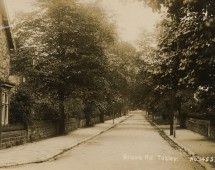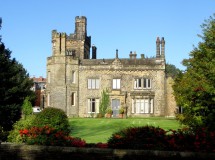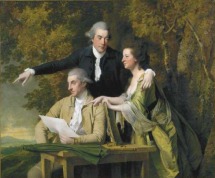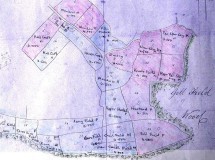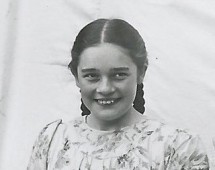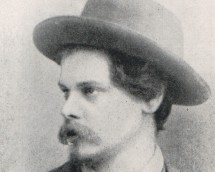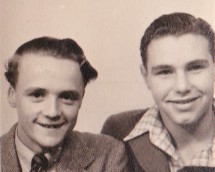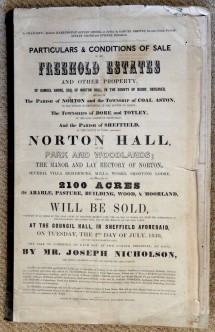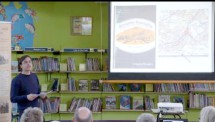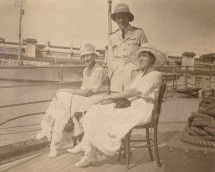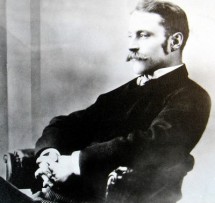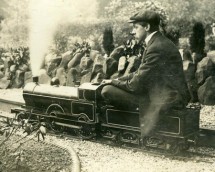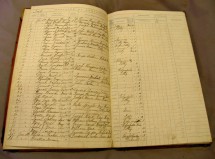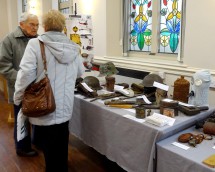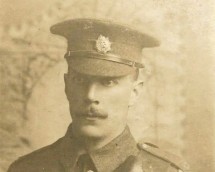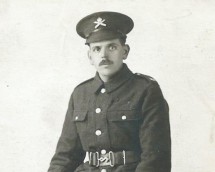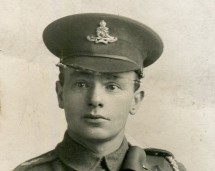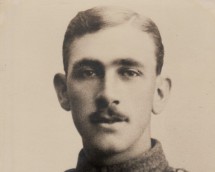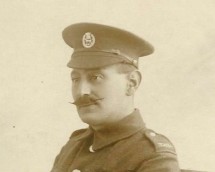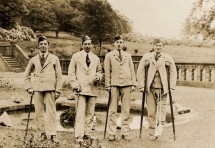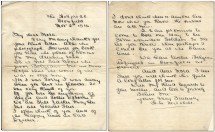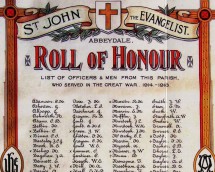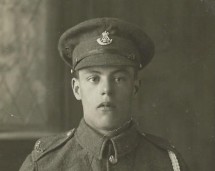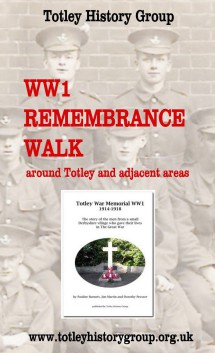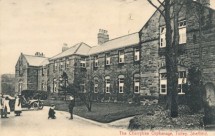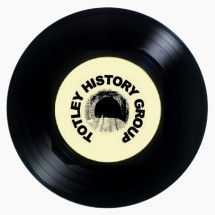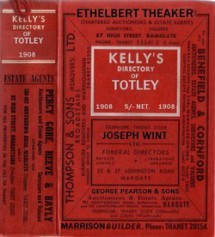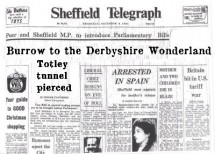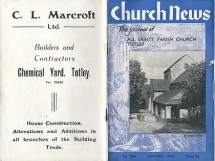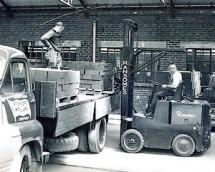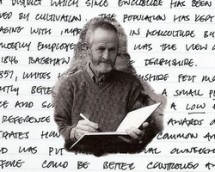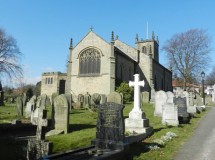The Plumbe Family
Mrs Kate Plumbe moved to Totley Rise from Mansfield, Nottinghamshire, around 1913 following the death of her husband, William Alvey Plumbe, two years earlier.
Kate had been closely connected with the Mansfield Congregational Church, where for a number of years she was the leader of the Young Women's Class. She was also an ardent temperance worker. The first indications we have of her moving to our area are on 17 October 1913 when a report appeared in the Sheffield Daily Telegraph in which she spoke at a meeting in the city to deplore the indifference towards the subject of temperance by members of the public in general and by members of the Christian churches in particular. On the same day a request was received by the Mansfield Church for her transfer to the Union Church, Totley.
We are not sure why Kate decided to move here but it may have been to be closer to younger members of her family. Her son Charles Conway Plumbe had already moved to the area to take up a position as
the local H.M. Inspector of Factories and her late husband had been guardian to two orphaned nieces, Constance Mary and Faith Marjorie Johnson, who were living in Sheffield.
In later life, Kate Plumbe was described as being of striking appearance whilst as a young woman she was said to be something of a beauty. If her views on religion and alcohol were somewhat narrow, she had a much lighter side to her character, being passionately fond of music - having a fine singing voice in her youth - and also of dancing and gardening, being particularly fond of roses. She was a woman of character, ability and charm, although some people were in awe of her as they felt they couldn't match her very high standards.
Kate was born Kate Stidston in Plymouth, Devon in 1854, the daughter of Samuel Stidston, a draper, and his wife Catherine Munford Conway. Kate's father's family came from Kingston, Devon where both her uncle and her grandfather, James Stidston, were farmers. Kate loved life on the farms and she was a keen horsewoman. Her grandfather on her mother's side, William Conway, was a Plymouth mason and later a builder.
It was whilst on a family holiday to the Scilly Isles that she met her future husband, William Alvey Plumbe, who was on a walking tour of the coasts of Devon and Cornwall. She was only 15 and he was ten years her senior, the son of Charles Plumbe and his wife Elizabeth Alvey. It appears to have been love at first sight on his part and she was undoubtedly very fond of him. The couple hardly saw anything of each other but corresponded for several years during which Kate refused four offers of marriage from William. It was said that when her mother died in 1873 and her father hastily remarried to a woman who was unacceptable to Kate, she decided to marry William "chiefly to get out of the house." The couple were married at Sherwell Congregational Church in Plymouth on 9 September 1875 and at the age of 21, Kate left Devon to join her husband who worked in his father's printing business in Sutton-in-Ashfield, Nottinghamshire. It was a happy and successful marriage.
During the next twenty years, William and Kate had ten children, two of whom died in infancy. The eight other children were: Agnes Catherine (1876-1954), Winifred (1877-1966), Hilda Margaret (1878-1956), Gertrude Elizabeth (1879-1970), Charles Conway (1881-1962), Olive Stidston (1884-1963), William Collingwood (1887-1918), and Gwyneth Evelyn Boyd (1894-1983). Agnes and Winifred were born in Sutton-in-Ashfield but by the time of the 1881 Census, the family had moved to 4 Argyle Street, Mansfield.
William Alvey Plumbe had multiple business interests which were initially run in partnership with his father under the style of Charles Plumbe & Son, printers, booksellers and stationers of Sutton-in-Ashfield and Charles Plumbe & Sons, chemical manufacturers at Mansfield. William also ran a coal merchants business at the Railway Coal Wharf, Mansfield. He took over his father’s printing business in 1874, moved it to Dame Flogan Street, Mansfield in 1884 and converted it from a partnership to a limited liability company in 1888. All whilst he continued to run the coal merchants, coal tar manufacturing and chemicals businesses. By the 1891 Census, the family had moved house again to Linden House, Chesterfield Road, Mansfield, which was already a substantial property before William enlarged it by building a billiard room.
It was William's great regret that he did not have much formal education but he was a great reader and he assembled an extensive library. Fond of both walking and botany, he would take the children on long 'botany walks' that began Agnes's interest in botany - she later took a degree in the subject at Girton College, Cambridge. The Plumbes were a musical family and William took full part having a pleasant but untrained tenor voice and playing the cello. William also liked cricket and he took Kate and other members of the family to watch Nottinghamshire County Cricket team play.
He was also a keen traveller and the family never went to the same place twice running for a holiday as there were so many more places to see. He and Kate would go overseas every year, sometimes taking their youngest daughter Gwyneth with them. The family still have the original passport that William applied for in 1875. It is a large sheet of paper embellished in the Victorian style and signed by the Earl of Derby. "For Mr. Wm. A. Plumbe and his wife to travel to the continent". William Alvey Plumbe died on 9 February 1911 at the age of 65.
By this time most of the children had left home and only Gwyneth remained. Conway had married 'Queenie' Lynham in 1908 and in the same year Olive married Thomas Mack. The following year Gertrude married Charles Don. Agnes, Hilda and Winifred were living overseas.
William Collingwood Plumbe had remained in Mansfield where, following the death of his father, he became managing director of the family printing business, Plumbe and Richardson Ltd., and manager of the Sherwood Chemical Works. He was called up in March 1917 and he served with the 9th Yorkshire Regiment and the 1/5th Gloucestershire Regiment. The greater part of his time was spent in Italy but in the autumn of 1918, following leave home in Mansfield, he was sent to France. He was wounded at Le Cateau on 23 October, invalided home and admitted to Edinburgh War Hospital, Bangour, near Broxburn. At first his wounds were not considered to be severe but after a fortnight he took a turn for the worse and died on 13 November 1918, just two days after the Armistice was signed. He was aged 32 and left a wife, Marion, and three children below the age of six. Before joining up William had been a member of the Territorials and a special constable. He was of a bright sunny disposition which endeared him to many people. He had been choir leader and Sunday School Superintendent at the Mansfield Congregational Church.
Gwyneth Plumbe attended the Queen Elizabeth Grammar School for Girls, Mansfield and the Dartford Physical Training College in Kent before becoming a teacher of Physical Education and English. Between 1915 and 1927 she worked in the United States, being recorded in the 1920 US Census as a teacher in Baltimore, Maryland. She came back home to Totley Rise most summers typically arriving in late June and returning to America in early September. At the beginning of World War 2 she worked for the ARP Casualty Transport Service at Llanfyllin in Montgomeryshire. In later life Gwyneth lived very happily in a Tudor cottage in Cranbrook, Kent where she enjoyed her music and her books. It was said that she would have liked to have become a professional violinist. She was of a good enough standard but in those days good orchestras did not employ women. Gwyneth Plumbe never married and died on 6 April 1983 at the age of 88.
The Plumbe's house in Totley Rise was at 1 Devonshire Road. Kate named it "Widdecombe", in memory of the happy days of her youth in Devon. The family also owned a house on Ashfield Avenue, Mansfield, that Kate named "Kingston" for similar reasons. Widdecombe had a lovely garden and a large drawing room with a grand piano and space for dancing - Jim Martin remembers going to parties there. The house was always well run by efficient domestic servants. Kate was happy there.
Between September 1915 and February 1917, Kate worked part time for the British Army Red Cross Volunteers and was involved with “knitting, needlework, war hospital supplies”, probably in support of the VAD Hospital at St. John’s Church Rooms. She then briefly managed the family businesses in the absence and then the death of her son William Collingwood, before they were handed over to local management but still under Plumbe family control.
Kate became a prominent member of the Totley Union Church and a Sunday School Superintendent but she also took an interest in other local churches, opening bazaars, chairing luncheons, presiding over concerts and fund raising events and, of course, giving speeches on matters close to her heart. She warned of the many distractions that now faced the church on Sundays, like motoring, gardening, golf and tennis. She accepted that to encourage people to attend, the church must appeal to people's musical tastes, literary tastes, educational tastes etc. but it must not forget to provide for their spiritual needs. She never wavered in her support for total temperance. In one speech to the Nether Congregational Church, Norfolk Street, in 1926 she related how whilst driving through the Sussex lanes, she came upon three signs bearing the words "Red Lion", "Black Swan" and "Blue Boar" respectively "and we weren't running into a zoological garden. The signs indicated some of the things which lead from the church."
After an illness lasting about a year, Kate Plumbe passed away on 8 May 1931 at the age of 77. The funeral took place at Mansfield Cemetery preceded by a short service at Totley Union Church. But that wasn't the end of the Plumbe Family's association with our area. Two of Kate's daughters, Winifred and Hilda, continued to have connections with our part of Sheffield for many years to come.
Hilda Plumbe attended the Bedford Teacher Training College between 1898 and 1899. At the time of the 1901 Census she was working as a teacher at the Wesleyan Girls College, Penzance. She was a missionary in Calcutta for about two years on a temporary basis covering for her sister Winifred who was ill, returning home in June 1908. Then between 1910 and 1911, Hilda taught in a school in Vancouver, Canada.
From October 1914 to April 1915, she worked 6 hours a day with the British Army Red Cross Society Volunteers as a cook in the VAD Hospital at St. John’s Church Rooms. She joined the Sheffield Transport Department where she was placed in charge of women bus conductresses. When they were disbanded at the end of the war, Hilda was made superintendent in charge of the Ticket Department, remaining in post until her retirement at the start of the World War 2.
Hilda was also the secretary of the Totley Union Church Dramatic Society from its inception in 1913 until 1954. The Society had begun as a Literary Society but by the mid 1920s "Dramatic Evenings" were the most popular items on the programme and a Dramatic Section was formed. In 1928 the old Literary Society was dropped and the new Dramatic Society took on ever more ambitious productions, encouraged by the building of a new church hall on Totley Brook Road to replace the old "Tin Tab". Hilda performed in these events which even featured the Society's own orchestra.
On 12 July 1899, at the annual speech day of the Queen’s Grammar School for Girls, Mansfield, it was announced that the name of their former pupil, Winifred Plumbe, had appeared in the Tripos lists at the University of Cambridge where she had gained a second class in the Mathematical Tripos. It would be more than twenty years, however, before her BA degree was conferred, as women were not full members of the University in those days. In the 1901 Census Winifred was shown as a teacher at the Girls County School in Abergavenny, Monmouthshire having spent the intervening twelve months at the Maria Grey Teacher Training College in London.
Missionaries were expected to do “deputation” work during their furloughs, visiting churches and organisations to tell them about their work. It was at one such event that Winifred was recruited. She applied to the Free Church of Scotland Board of Foreign Missions in July 1901 - despite being a Congregationalist - and on 31 December the same year she set sail aboard the Mombassa bound for Calcutta via the Suez Canal. She studied and passed examinations in Bengali. Most of her 37 years in India were at the Calcutta High School but between 1934 and 1938 she was the head of the Bachelor of Teaching Department of the Scottish Church College, Calcutta.
After her retirement in 1938, Winifred returned to England to live with her sister Hilda at 60 Furniss Avenue, Totley Rise, a property they named "Linden House" in memory of their parents' home in Mansfield. The two sisters shared housework with Winifred doing the cooking and Hilda doing the cleaning. They still travelled both at home and abroad enjoying separate holidays so that they could see as many places as possible and share their experiences with one another. Hilda Plumbe died on 4 November 1956 aged 78 and her sister Winifred died on 30 April 1966 at the age of 88.
We would like to thank the Plumbe Family for the use of family photographs and for their considerable help in researching this article. Any mistakes are entirely our own.
More information about the well-educated and well-travelled Plumbe family may be found in Freda Higgins' book A Family Record: The Browns, Cargills and Plumbes.
Plumbe Family - A4 Print Version.pdf
Adobe Acrobat document [668.3 KB]
Search Our Website Here
September
October
November
Unless stated otherwise our meetings are held in Totley Library on the 4th Wednesday of each month at 7.30pm.
Pauline Burnett's book The Rise of Totley Rise has been revised and updated. It tells the story of this small piece of land from 1875 when there was only a rolling mill and chemical yard alongside the river a mile from Totley, through Victorian and Edwardian times, two world wars and up to the present day. It has 94 pages including a useful index and many illustrations from private collections. The book is available now from Totley Rise Post Office priced at £5, or through our website when an additional charge will be made to cover packing and postage.
A few copies are still available of Sally Goldsmith's book Thirteen Acres: John Ruskin and the Totley Communists. Totley was the site of a utopian scheme funded by art critic and social reformer John Ruskin. In 1877 he bought 13-acre St. George’s Farm so that nine Sheffield working men and their families could work the land and, to keep themselves busy, make boots and shoes. Sally tells an engaging story from our history with a quirky cast of characters including Ruskin himself, the poet and gay rights activist Edward Carpenter and Henry Swan, a cycling, vegetarian artist and Quaker. The book is available to order online from the The Guild of St. George by following this link.
A recently discovered box of WWII correspondence reveals the story of how a small group of ladies from Dore and Totley recruited knitters from the west of Sheffield and how their efforts made them the country's greatest provider of Comforts for the Minesweeping crews of the Royal Navy. The story is told in Knit For Victory, a new book from Totley History Group. Written by Pauline Burnett, it has 82 pages and many illustrations. It is on sale in local shops and via our website. Further information about the correspondence is in this inside page of our website: Dore & Totley Minesweeping Trawlers Comforts Fund.
The story is told in Totley War Memorial WW1 of the ten men from our village who gave their lives in the Great War. Written by Pauline Burnett, Jim Martin and Dorothy Prosser, a chapter is devoted to each of the soldiers with a family tree followed by as much information as could be discovered about the men and their families. There is also information about their military careers and the actions in which they lost their lives. The book has 64 pages and is illustrated throughout with photographs of the men, their families and the houses where they lived.
Totley All Saints' Church Parish Magazines for the years 1985-2006 with notices of baptisms, marriages and funerals and accounts of spiritual, educational, charitable and social matters in the village. Scanned in full, including advertisements from local traders.
In 1893 during the building of the Totley Tunnel there was an outbreak of smallpox amongst the navvies which spread to some of the local population. 17 people were buried in communal graves in Dore Churchyard, 6 from "Green Oak" (Lemont Road). The severity of the outbreak was principally caused by overcrowding and insanitary conditions in lodging houses .
Kathleen Grayson was a 39 year old housewife when WW2 broke out. She volunteered for the ARP and became an ambulance driver. During an air raid on Sheffield in July 1941, and despite her own injuries, she managed to get a seriously injured casualty to hospital. For this she was awarded a commendation from King George VI. Together with her friend Hilda Duffy, Kathleen also assembled a team of knitters to provide essential warm clothing for the men serving on the minesweepers patrolling the North Sea.
We have recently bought at auction the WW2 memorabilia of Douglas Platts whose family home was at Hillside, 98 Queen Victoria Road. After the war Douglas returned to his civilian occupation working in the family scissors manufacturing business. He lived in our area for the rest of his life.
We are very grateful to Mrs Valerie Taylor of Dore for lending us the title deeds to Lower Bents Farmhouse which is reputed to be the oldest surviving building in the area with a proven history back to 1621. We have now scanned and transcribed the deeds which could be particularly interesting to anyone with a connection to the local Fisher, Dalton and Marshall Families.
Until 1844, when Dore Christ Church parish was created, Totley township was part of Dronfield parish. We have now transcribed the burial records for former Totley residents at St. John the Baptist, Dronfield for the period 1678-1870 and at St. Swithin, Holmesfield for the period 1766-1901.
Whilst researching the history of the Dalton Family we found it useful to transcribe a number of early Wills and Inventories. These and those of many other Totley, Dore and Holmesfield people dating from between 1594 and 1856 have now been added to our website.
St. Swithin's Church, Holmesfield pre-dates Dore Christ Church and was the place where many of the people from Totley worshipped and were baptised, married and buried. Read the inscriptions on more than 750 gravestones in the churchyard including those of Mr. and Mrs. William Aldam Milner of Totley Hall, Jessie Matilda Tyzack (nee Fisher) of Avenue Farm, and Rev. J. A. Kerfoot of St. John's, Abbeydale.
Thomas Youdan was a music hall proprietor and benefactor who was living at Grove House, Totley in 1867 when he sponsored the first football knockout competition in the world for The Youdan Cup.
The words Millhouses Cricket Club can be seen in the background of team photos which are likely to date from between 1905 and the early 1920s, very probably pre-war. They were lent to us by Garth Inman who can identify his great uncle, Cecil Inman, in some of the photos and would like to know when they were taken and, if possible, the names of others present. Please take a look to see whether you can put names to any of the faces.
Josiah Hibberd was seriously injured whilst working on the construction of the Totley Tunnel in 1892. He died on 9 May 1897 at the age of 38 having apparently spent most of previous five years in hospital.
Bradway House was built around 1832 by Henry Greaves, a farmer, together with two adjacent cottages. We have traced most of the occupants of the property from these early days up to the start of World War Two.
We have transcribed the baptisms records at St. John the Evangelist, Abbeydale from when the church was consecrated in 1876 until just after the start of World War 1. The records are arranged in alphabetical order based upon the child's name and show the date of baptism, the names of the parents, their home location and occupation.
Nick Kuhn bought an original 1920s poster which had this owners' blind stamp in one corner. The stamp almost certainly refers to a house named Wigmore that was built in the late 1920s or early 1930s. The first occupiers that we can trace are John Howarth Caine, a district mineral agent for the LNER, his wife Florence Jane (nee Prince) and daughter Doris Mary. The Caine family lived at Wigmore until 1936 by which time the house would have been known simply as 12 The Quandrant.
George Griffiths died on 13 December 1888 following an explosion during the sinking of number 3 airshaft at Totley Bents. His widow Florence died shortly afterwards and his two daughters Maud and Annie were adopted separately. Whilst Annie lived the rest of her life in Yorkshire, Maud emigrated to Australia in 1923 with her husband, John Burrows, daughter Margaret and son Jack, pictured above.
George Wainwright was said to have been born in Bamford, Derbyshire in 1714. He learned the trade of linen weaving and moved to Totley after his marriage on 1744. He became an ardent follower of John Wesley who paid many visits to Sheffield and who would have passed through or close to Totley. Preaching was at first conducted out of doors and when Wesley's preachers became harassed by a mob of Totley ruffians in 1760, George offered them safety of his own home. He remained a Methodist for all of his long life, dying in Dore in 1821 at the reputed age of 107.
Oakwood School was started by Mrs Phoebe Holroyd in 1925 initially as the Firth Park Kindergarten and, by 1927, as the Firth Park Preparatory School. Phoebe was still working at the school almost fifty years later when she was well into her seventies. We would like to hear from anyone with memories of the school.
James Curtis was born at sea aboard HMS Chichester in 1790. He enlisted as a Private in the 1st Grenadier Regiment of Foot Guards in Sheffield in 1812 and served in Spain and Portugal during the Peninsular War. He later fought in France and Belgium taking part in the Battle of Waterloo. In later life James lived at the Cricket Inn where his son-in-law William Anthony was the licensed victualler. He died in Heeley in 1882 aged about 91.
Charles Paul lived in Totley in later life. He was a local historian and archaeologist who was an authority on the history of Sheffield, especially the two areas he knew best: Attercliffe and Ecclesall. His books and letters to local newspapers were published under the Latin form of his name Carolus Paulus.
Towards the end of the 19th century Totley Hall gardens became a well known beauty spot that attracted many hundreds of visitors from Sheffield on open days and the rock gardens became one of its most popular features. Mrs Annie Charlesworth sent us six glass transparencies of the rock gardens taken, we believe, in the early years following the Great War.
Anton Rodgers send us photographs of three water-colours that had been bought by his grandfather at a sale of the contents of Abbeydale Hall in 1919. One was of a scene said to be in York by A. Wilson. A second was of a seated child with a dog believed to be pianted by Juliana Russell (1841-1898). The third was of Lake Como, by Ainslie Hodson Bean (1851-1918) who lived for much of his life on the Riviera and in North Italy.
A Canadian correspondent sent us photographs of a set of silver spoons that were bought in a small town in British Columbia. The case contained a note signed by Ebenezer Hall indicating that they were a wedding gift to Maurice and Fanny Housley. We think we may have traced how they got to Canada and where they might have been since.
Green Oak Park was opened on 23 March 1929 on land that had been bought by Norton District Council from John Thomas Carr, a farmer and smallholder of Mona Villas. In later years, the buildings were used by the Bowling Club (the green having been built in 1956) and by the park keeper. However, the buildings appear to have been constructed in several phases, the oldest of which predates the park to the time when the land was used for pasture.
We believe the old Totley Police Station at 331 Baslow Road was built around 1882. Two lock-up cells were excavated just below floor level in the summer of 1890. We have traced the Derbyshire Constabulary police officers who lived there from John Burford in 1886 to George Thomas Wood who was there when Totley was absorbed into Sheffield in 1934.
David Stanley lived in Totley Rise in the later years of his life. Born in Bulwell, Nottinghamshire, he joined the 17th Lancers when he was 19 and rode in the Charge of The Light Brigade at the Battle of Balaclava where he was seriously wounded. For the first reunion of veterans in 1875, he told his story to a reporter from the Buxton Herald.
This picture postcard was addressed to Miss Abell, Holly Dene, Totley Brook Road and posted in Rotherham on 10 December 1907. Edith Annie Abell was born on 4 February 1887 in Sheffield and her family came to live in our area in the 1900s, staying for the rest of their lives.
Charles Herbert Nunn enlisted in the British Army on 23 August 1915 and was sent to France on 18 December 1915 to served with the British Expeditionary Force. In March 1916 it was discovered that he was underage and he was returned home. Shortly after his 18th birthday he re-enlisted and was again posted abroad where, in addition to this trio of medals, he was awarded the Military Medal.
This certificate was awarded jointly by the Red Cross and St. John's Ambulance to Isaac Henry Williams, of Lemont Road, for his services during WW1 as a stretcher bearer. We are seeking anyone who can help us pass it on to a living relative.
In 1832 Samuel Dean pleaded guilty to stealing a quantity of lead from the Totley Rolling Mill and was sentenced to seven years transportation to Australia. He sailed on the Mangles and upon arrival in New South Wales he was sent to work for William Cox, the famous English explorer and pioneer. After receiving his Certificate of Freedom in 1840, Samuel became a farmer and went on to have a very large family. Samuel was born in Whitechapel around 1811 to parents Samuel Dean Snr. and Susannah Duck. His descendant Sarah Dean would like help in tracing his ancestry.
Ellen Topham was born in 1889 in Nottingham. Her parents had been living together since 1862 but had never married so it was most unusual that, after their deaths, Ellen was accepted into Cherrytree Orphanage. Even more so since her father, Snowden Topham, had been acquitted somewhat unexpectedly in a widely reported manslaughter trial. Ellen remained at Cherrytree until her death from pulmonary tuberculosis at the age of 15.
Mabel Wilkes was a resident in Cherrytree Orphanage between 1897 and 1905. Her granddaughter Sally Knights sent us these images of a book presented to Mabel as a prize for her writing. Sally also sent us some personal memories of her grandmother and a photograph of a locket which contains portraits of Mabel and her husband Septimus Gale.
John Henry Manby Keighley was living at Avenue Farm when he enlisted in 1916. He fought in France with the Cheshire Regiment but after home leave in early 1918 he went missing. The Army were unable to determine whether he had deserted or returned to the front and been either killed or captured by the enemy. In August 1919 he was formally presumed killed in action but it appears he did not die but returned home to his family.
Horace Ford was admitted to Cherrytree Orphanage on 26 October 1888 at the age of six. He left at the age of 14 to become an apprentice blacksmith and farrier. Soon after his 18th birthday Horace enlisted in the Imperial Yeomanry to serve his country in the war in South Africa. His letter home to his Orphanage mentor tells of the lucky escape he had in battle.
Pat Skidmore (née Sampy) lived on Totley Brook Road from 1932 to 1948 before her family moved to Main Avenue. In this short article she remembers her time at Totley All Saints School where she was a contemporary of Eric Renshaw and Bob Carr.
As we have nowhere to exhibit memorabilia and artifacts, we have created a Virtual Museum instead. The latest addition to our collection is this double-sided Totley Rise Post Office oval illuminated sign which was on the wall of 67 Baslow Road before the Post Office business transferred to number 71. Please contact us by email if you have things that you own and would like to see added to the virtual museum.
Conway Plumbe was a man of many talents who came to live in Totley Rise around 1912. As a young man he had poems published by Punch magazine and is remembered in modern collections of WW1 poetry. A number of his paintings were accepted by the Royal Academy. An engineering graduate of London University, he joined the Civil Service where he rose to a high level as a factory inspector, publishing two books on the subject and giving a series of talks on workplace health and safety on BBC radio during WW2. In retirement he wrote a philosophical-spiritual work called Release From Time.
Inside Totley Rise Methodist Church there is a Roll of Honour commemorating the soldiers from its congregation who served their king and country during the Great War. For all but one of the 28 names the soldier's regiment is recorded in the next column. The exception is David Cockshott for whom 'killed in action' is written alongside yet he appears on no war memorial in our area and no record of a mortally wounded soldier of that name is to be found. We think we have solved the mystery.
Mrs. Kate Plumbe moved from Mansfield to Totley Rise with a number of her family in 1913 and became closely involved with the Totley Union Church. Her daughter Winifred became a missionary and headmistress in Calcutta for over 38 years following which she returned home to live with her sister Hilda on Furniss Avenue. Hilda had also been a teacher, missionary and, like her mother, a volunteer at St. John's VAD during WW1.
Thomas Glossop was a cutler and razor manufacturer who was well known amongst cricketing and gardening circles. Despite going blind, he was able to continue his hobbies with remarkable success
The Totley Union Cycling Society Prize Giving and Fete was held on the fields near Abbeydale Hall on 18 July 1914. Anne Rafferty and Gordon Wainwright have named some of the people in two wonderful photographs of the event. Can you identify any more for us?
The Tyzack family are well known in our area for owning iron and steel trades at Walk Mill, Abbeydale Works, Totley Rolling Mill and Totley Forge. This article covers the history of the family from the late 18th century when William Tyzack the founder of the company was born until the early 20th century when Joshua Tyzack farmed at Avenue Farm, Dore.
Walter Waller Marrison moved to Totley around 1897 with his wife and their two young sons. He was a house builder who constructed properties around Totley Brook and Greenoak before ill health forced him to take up less physically demanding work. In 1904 he took over the tenancy of the grocers and off licence at number 71 Baslow Road. After his death in 1908, his widow Kate and later their eldest son Jack continued to run the business until it was sold in 1934.
Ron Wijk of Nieuw-Vennep in the Netherlands has sent us two scanned images of drawings of old cottages made by the celebrated Dutch painter, Anton Pieck (1895-1987) simply annotated "Totley", and wondered whether we could identify their locations.
We would like to thank Christopher Rodgers for bringing to our attention this fascinating log of the 85th Sheffield (St. John's and Totley Orphanage) Wolf Cub Pack for 1927-45. The log is published jointly by Sheffield Scout Archives and Totley History Group as a free PDF download. It is illustrated by no fewer than 92 photographs and is supported by a comprehensive index and biographies of some of the main participants.
Following our Open Meeting event on School Days, Roger Hart, Howard Adams and John Timperley have each written to us with their memories of Norwood School, which was located in the rooms attached to the Dore & Totley United Reformed Church on Totley Brook Road.
On 22nd July 1909 the children of Dore and Totley Schools celebrated by a pageant the union of England under King Ecgbert which took place at Dore in AD 827. The pageant was devised and written by Mrs Sarah Milner and her daughter Marjorie and performed in a field close to Avenue Farm in front of a large audience. Photographs of the event survive together with a fragment of the script.
John Edward Greenwood Pinder had lived all 46 years of his life in Totley but on census night, Sunday 2 April 1911, he was not at home; he was in Derby Gaol serving a sentence of three months hard labour. From the age of 20, John had been in and out of local courts for a series of minor offences including drunkenness, assault, wilful damage and night poaching. Finally he was sent to gaol for cutting down and stealing 86 small trees which he sold in Sheffield market for Christmas.
We have already transcribed the census returns for Totley, Totley Rise and Dore. Now we have transcribed Census Strays. These are people who were born in Totley but are missing from our earlier transcriptions. They may have been living, working or studying elsewhere or just away from home on the night the census was taken. Two people were in prison. Others were in Union Workhouses, hospitals and asylums. Fully indexed strays from the 1851, 1861, 1881, 1891, 1901 and 1911 censuses are available now.
We wish to thank Gillian Walker for allowing us to digitize an archive of material about the 1st Totley Scout Group. Most of the material was collected by Arthur Percival Birley in the period 1949-51 and there are many interesting documents pertaining to the building of the scout hut on Totley Hall Lane. In addition four Newsletters survive, two from the 1940s and two from 1971.
We are grateful to Angela Waite and All Saints' Parish Church for giving us access to baptismal and kindergarten birthday rolls dating from 1926 to 1941. We have transcribed the names, addresses, birthdates and baptismal dates and created an alphabetical index of entries for you to search.
Edmund Sanderson, a Sheffield estate agent, aquired the land on either side of the old drive to Totley Grove in 1874 and divided it into plots for development. He called it the Totley Brook Estate. But before many houses were built, the estate road was severed in two by the building of the Dore & Chinley Railway line. The eastern end of the road became the cul-de-sac we now call Grove Road.
John Roberts was born in Sheffield in 1798. He became a partner in one of the leading silversmiths firms in the city before moving to Abbeydale Park in 1851 and extending the house in Victorian gothic style. He paid for the building of St. John's Church and was believed to dispense more in charity than any other person in the neighbourhood including his protege Ebenezer Hall.
The Coke Family owned the Totley Hall Estate from 1791 to 1881. With the aid of a family tree to guide us, Josie Dunsmore takes us through the story of their tenure.
When the Rev. D'Ewes Coke inherited the Totley Hall Estate in 1791 it had two farms. Josie Dunsmore tells the story of how the two farms were combined under the tenancy of Peter Flint with the aid of field maps drawn by Flint himself and later by the Fairbanks family.
Do you think you recognize this face? More than sixty photographs of the girls and teachers at Hurlfield Grammar School for Girls in the 1940s were given to Totley History Group by Avril Critchley, who was herself a student at the school. The collection includes fifteen form photographs from June 1949. There would have been a number of girls from the Totley area attending the school in those days.
Christine Weaving tells the story of her 2 x great uncle George Edward Hukin, a Totley razor-grinder, and his life-long friendship with the academic, poet, writer, and free-thinker Edward Carpenter.
Eric Renshaw (pictured here on the right with Bob Carr) grew up and lived in Totley from 1932 to 1960. Many of his memories are of a sporting nature.
We are very grateful to Gordon Grayson for giving us this splendid sale document for the Norton Hall Estates, following the death in 1850 of Samuel Shore. The estates included a large part of Totley and the document has maps and illustrations, plus schedules of land and property with the names of tenants. We have also added a transcription of the entries for Totley and Dore.
Watch this Youtube video of the talk given by Dr. Mark Frost and Sally Goldsmith on Ruskin, Totley and St. George's Farm. The talk was hosted by Totley History Group on 20th May 2015 as part of the Ruskin in Sheffield programme. Also enjoy a video of the outdoor performance Boots, Fresh Air & Ginger Beer written by Sally.
When Jacqueline A. Gibbons became interested in what made her father tick, it began a journey through WW1 archive records and led to her flying from Toronto to visit the house and village where he lived and the countryside that he so much enjoyed. Jacqueline reminds us that in the early 20th century Sheffield was a driving force of industry and that Totley was the place where many of its remarkable people lived and where they formulated their ideas.
Edgar Wood was the designer of The Dingle, 172 Prospect Road, built in 1904 for Rev. William Blackshaw, the founder of the Croft House Settlement. The house, together with its western terrace and boundary walls, has now been awarded Grade II listed building status.
What was probably "the most perfect little garden railway in existence" in 1910 was to be found in the grounds of Brook House, Grove Road, the home of its designer and constructor, Guy Mitchell. Look at some wonderful photographs and read reports in newspapers and a full appreciation in Model Railways magazine.
We have now completed our transcription of Totley School's Admission Records for the period from 1877 to 1914. There is also a useful index to the names of the scholars and to their parents or guardians. We are very grateful to Sheffield Archives and Local Studies Library for allowing us to transcribe and publish these records and for permission to reproduce the photograph of a specimen page of the register.
On 8, 9 and 11 November 2014 Totley History Group held an exhibition at Dore & Totley United Reformed Church to commemorate the centenary of the First World War. Below are additional links to some of the photographs we were lent and stories we researched especially for the exhibition.
Oscar Creswick was a local farmer who served with the Army Service Corps in Salonika and who after the war returned to Totley to become the innkeeper of the Cricket Inn and a member of the village's successful tug of war team.
Walter Evans was a market gardener who also ran a small grocery shop on Hillfoot Road when war broke out. He fought with the Machine Gun Corps at the fourth battle of Ypres. After the war, Walter ran a grocers shop at the top of Main Avenue.
Fred Cartwright was another Totley soldier who survived the Great War. He fought in France and Belgium and although he wasn't wounded he was gassed and was home on sick leave when his daughter was delivered by Nurse Jessop during a snowstorm in January 1917.
Maurice Johnson joined the Yorkshire Dragoons, a territorial unit, on 1 Jan 1914 and so was called up at the very start of the war. He fought throughout the war on the Somme, at Ypres and at Cambrai. After demobilization in 1919 Maurice returned to his old occupation in the steel industry.
Bill Glossop lent us a letter written by his father, William Walton Glossop to his wife describing life in the army during training in the north east of England and asking her to keep him in mind with the children.
The photo above provides a link to an album of photographs taken of WW1 Hospitals at St. John's, Abbeydale and the Longshaw Estate.
Nora Green, of Chapel Lane, was only 14 when war broke out. In 1914 she was ill with diphtheria and was sent to the isolation hospital at Holmley Lane, Dronfield. Nora recovered and wrote a letter of thanks to one of the hospital staff and the reply she received survives.
We have collected together on this page the names of local men who appear on various War Memorials and Rolls of Honour in Totley, Dore, Abbeydale, Norton, Holmesfield and Dronfield.
Unfortunately we were unable to identify all the photographs we were lent of Totley Soldiers. Please take a look at this album to see if you recognize any of the missing names.
This walk visits locations that have strong associations with Totley during the First World War. It includes the homes of the ten soldiers from the village who lost their lives, the auxiliary hospitals, war memorials, and even the rifle range on which the soldiers trained. Take a look at the first draft of a new walk by the authors of "Totley War Memorial WW1 1914-1918"
We wish to thank the Trustees of Cherrytree for giving us permission to publish transcriptions of the Cherrytree Orphanage Admissions Book entries for the years 1866-1929. There is also an alphabetical index for you to look at.
With more people having access to faster broadband and mobile networks, we have uploaded seven full and unedited oral history recordings and also added more short excerpts for you to listen to.
Our transcriptions of local trade directories have been expanded to cover the 95 years from 1837-1932 and have also been indexed. From the days when there were a handful of farmers, stone masons, saw handle makers & scythe grinders to the wonders of the Totley Bridge Garage Company, Betty's Boudoir and The Heatherfield Shopping Centre.
We continue to add to our Totley Newspaper Archive. Recent entries have included several about The Plumbe Family, Thomas Glossop and accidents during the construction of Totley Tunnel.
Totley Church of England Parish Magazines for the years 1922-1939 and 1948-1967 with notices of births, marriages and deaths and accounts of spiritual, educational, charitable and social matters in the village.
Around 90 photographs taken by Stuart Greenhoff for his thesis A Geographical Study of Dore and Totley including several of Totley Moor Brickworks. Superb!
Chronologically ordered snippets of information recorded by Brian Edwards during his many years of research into our local history.
Read the inscriptions on more than 700 gravestones in the churchyard.
Visitors since 24 Sep 2012:


